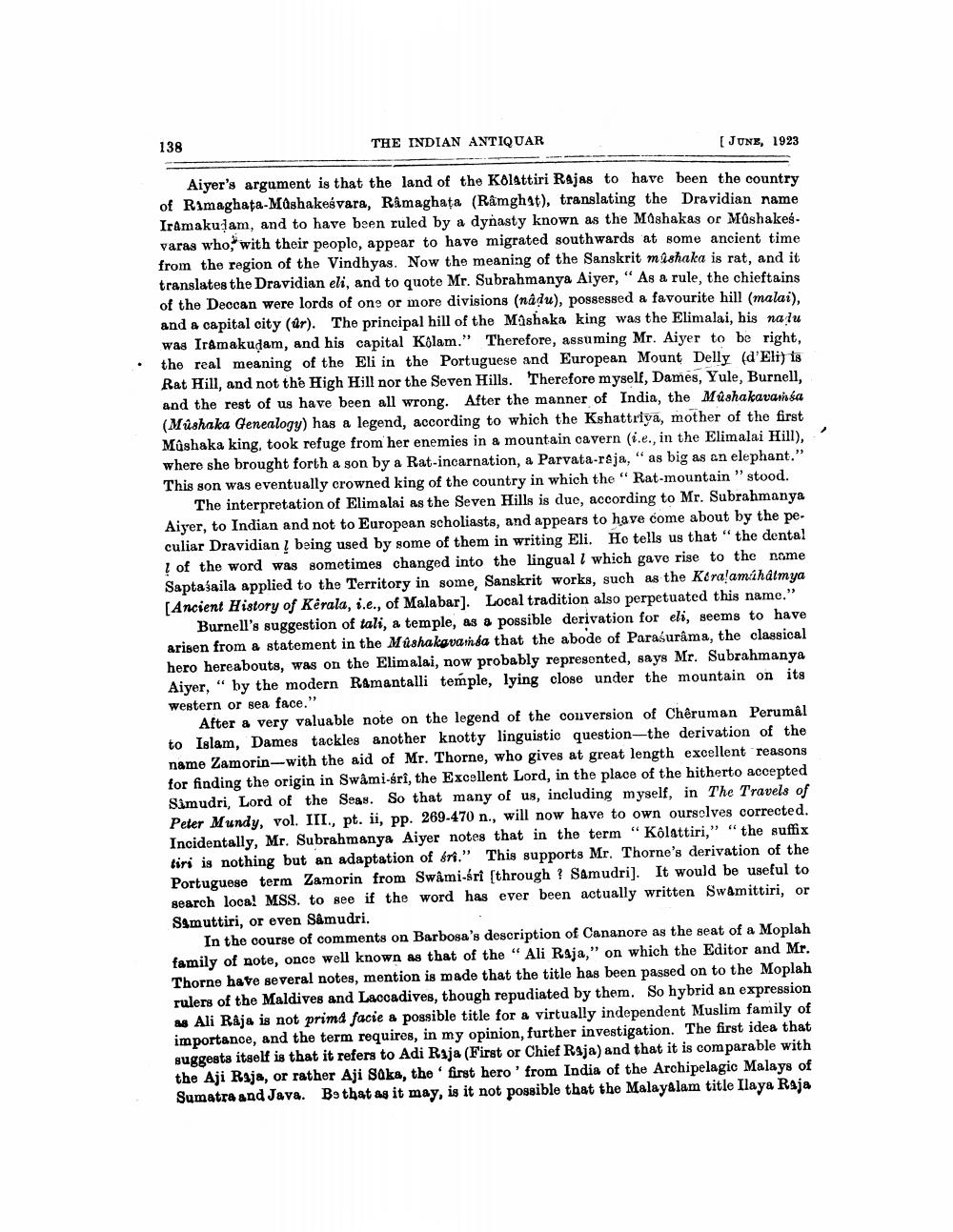________________
138
THE INDIAN ANTIQUAR
[JUNE, 1923
Aiyer's argument is that the land of the Kolettiri Rajas to have been the country of Rimaghata-Mshakešvara, Ramaghata (Râmghat), translating the Dravidian name Iramakulam, and to have been ruled by a dynasty known as the Moshakas or Mshakes. varas who," with their peoplo, appear to have migrated southwards at some ancient time from the region of the Vindhyas. Now the meaning of the Sanskrit mashaka is rat, and it translates the Dravidian eli, and to quote Mr. Subrahmanya Aiyer, “ As a rule, the chieftains of the Deccan were lords of one or more divisions (nádu), possessed a favourite hill (malai), and a capital city (ar). The principal hill of the Mashaka king was the Elimalai, his nału was Iramakudam, and his capital Klam." Therefore, assuming Mr. Aiyer to be right, the real meaning of the Eli in the Portuguese and European Mount Delly (d'Eliis Rat Hill, and not the High Hill nor the Seven Hills. Therefore myself, Dames, Yule, Burnell, and the rest of us have been all wrong. After the manner of India, the Múshakavansa (Múshaka Genealogy) has a legend, according to which the Kshattriya, mother of the first Mashaka king, took refuge from her enemies in a mountain cavern (i.e., in the Elimalai Hill), where she brought forth a son by a Rat-incarnation, a Parvata-raja," as big as an elephant." This son was eventually crowned king of the country in which the "Rat-mountain "stood.
The interpretation of Elimalai as the Seven Hills is due, according to Mr. Subrahmanya Aiyer, to Indian and not to European scholiasts, and appears to have come about by the pe. culiar Dravidian ? being used by some of them in writing Eli. He tells us that "the dental ! of the word was sometimes changed into the lingual l which gave rise to the name Saptažaila applied to the Territory in some, Sanskrit works, such as the Keralamahatmya [Ancient History of Kerala, i.e., of Malabar]. Local tradition also perpetuated this name."
Burnell's suggestion of tali, a temple, as a possible derivation for eli, seems to have arisen from & statement in the Müshakavamsa that the abode of Parasurama, the classical hero hereabouts, was on the Elimalai, now probably represented, says Mr. Subrahmanya Aiyer," by the modern Ramantalli temple, lying close under the mountain on its western or sea face."
After a very valuable note on the legend of the conversion of Chêruman Perumal to Islam, Dames tackles another knotty linguistic question--the derivation of the name Zamorin-with the aid of Mr. Thorne, who gives at great length excellent reasons for finding the origin in Swami-sri, the Excellent Lord, in the place of the hitherto accepted Simudri, Lord of the Seas. So that many of us, including myself, in The Travels of Peter Mundy, vol. III., pt. ii, pp. 269-470 n., will now have to own ourselves corrected. Incidentally, Mr. Subrahmanya Aiyer notes that in the term "Kölnttiri," "the suffix tiri is nothing but an adaptation of fri." This supports Mr. Thorne's derivation of the Portuguese term Zamorin from Swâmi-sri [through ? Samudri). It would be useful to search loca! MSS. to see if the word has ever been actually written Swamittiri, or Samuttiri, or even Samudri.
In the course of comments on Barbosa's description of Cananore as the seat of a Moplah family of note, once well known as that of the "Ali Raja," on which the Editor and Mr. Thorne have several notes, mention is made that the title has been passed on to the Moplah rulers of the Maldives and Laccadives, though repudiated by them. So hybrid an expression as Ali Raja is not prima facie a possible title for a virtually independent Muslim family of importance, and the term requires, in my opinion, further investigation. The first idea that suggests itself is that it refers to Adi Raja (First or Chief Raja) and that it is comparable with the Aji Raja, or rather Aji Saka, the first hero' from India of the Archipelagic Malays of Sumatra and Java. Be that as it may, is it not possible that the Malayalam title Ilaya Raja




